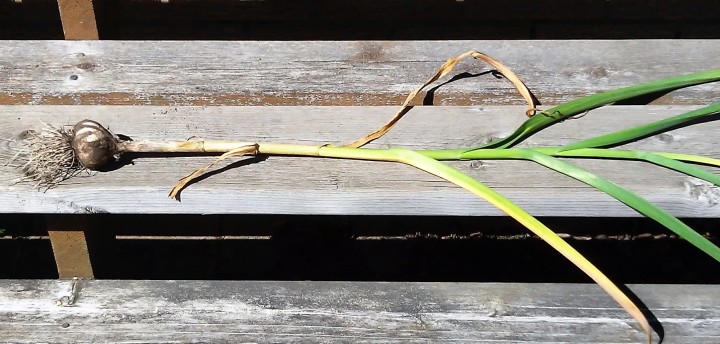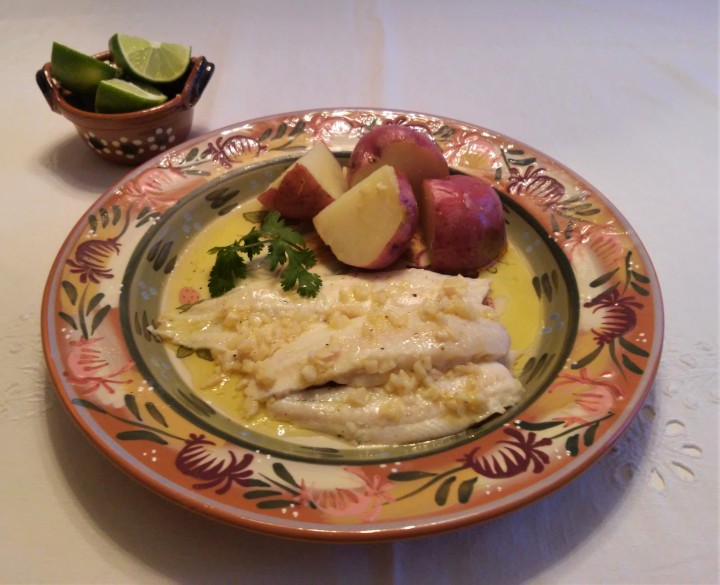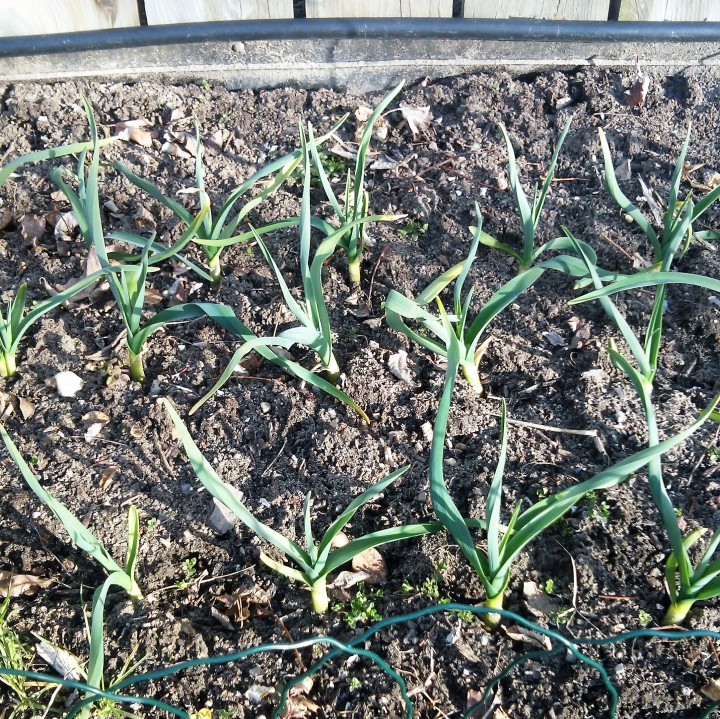
Garlic (Allium sativum) is such a sturdy plant, and counts with so many varieties, that it is suitable to grow in most gardening zones, from 3 to 9; this means that, other than the poles and the jungle, it should be possible to enjoy homegrown garlic anywhere. In my 6B gardening zone, I have been monitoring the cloves that I sowed in the fall, just making sure they had sufficient water throughout their growing season:
Garlic crops are so noble, they even tell the gardener when to harvest. Once at least three leaves have turned yellow, it is time to dig the fragrant gems. Dirt must be carefully loosen up around the bulbs, without scratching, and under the roots since they are surprisingly deep:
I like to check one or two plants first, to see how the bulbs have developed (see photo at the top of the post.) My sample looks well developed, with three nicely dried leaves (each corresponding to a papery layer on the bulb) and a fourth leaf yellowing. The temptation to just cook them or make into a delicious Middle Eastern garlic sauce is great, but impatient gardeners (like me) must take a deep breath and wait to have the whole crop out of the soil. This is because about a quarter of the bulbs will be selected and saved to be sown in the fall, for next year’s crop. It is very tempting to eat the biggest and plumpest, and sow the smallish ones, since some gardeners say it makes no difference. I tried myself one year, saving mostly big bulbs and a couple of the small ones to compare; for me, it was the bigger – the better, so now I know to save the biggest for planting. I have received a couple of requests asking for instructions on how to grow garlic, and summer is the right time to start. As discussed, the first step is to secure a good supply of bulbs; that is why, for the returning garlic grower, harvest of the current crop and planning for the next occur at the same time.
For first-time growers: some people buy supermarket garlic with reported success, but others recommend against it, unless it is organic (bulbs at supermarkets have often been treated with sprouting inhibitors, for longer shelf life) and local (for a better chance of thriving). I have found that organic, local garlic, is almost as expensive as ordering from a seed company, which has the advantage of having a large selection from the catalogues. It is an investment (mine were about $15CAD for one pound, plus shipping and handling), but you only have to buy the bulbs once. If you order in the spring or summer, the seed companies will make note of your gardening zone, and send the bulbs around the corresponding optimum sowing time, in the fall; for 6B is around mid-September, but for example in 8B, it is late October (with possibility of sowing as late as early December.) So for now, for the Northern hemisphere, it is time to save/order bulbs; I will follow up in September with sowing and care information. For details on how to select the best varieties for specific gardening zones, there is plenty of information on-line. In a nut shell, there are two groups of garlic: hardneck garlic is better suited for cold climates, and softneck for milder zones. In terms of characteristics, hardneck have complex flavours and produce scapes (edible flower buds), whereas softneck have more cloves per bulb and a longer shelf life, so these properties might influence the choice as well.
The medicinal and nutritional value of garlic is well known and documented, and its versatility in many cuisines makes it a staple in any kitchen. Although not native to Mexico, once available after the Spanish conquest, it became an important ingredient in many of what are now considered vintage recipes, for example, see my post on fish filets in garlic sauce (al mojo de ajo), which I have updated with a printable recipe.

It is a delicious way to enjoy garlic; the only pertinent extra advice, is to share this and any other garlic dishes with friends and family, so the strong scent will not be as noticeable. On the bright side, it should for sure keep vampires away.













Hi Irene, I’m growing garlic now in subtropical Australia – so some timely advice! Cheers.
LikeLike
Hello, Universal Gardener! While writing the post, I was hoping somebody from the Southern hemisphere would comment, since I have no clue as how your growing seasons go. What stage are you at with your garlic? Are you going to post about it? Thank you for your comment
LikeLiked by 1 person
I hadn’t thought about posting about garlic but I might now.
LikeLiked by 1 person
Looking forward to reading your post if you do!
LikeLiked by 1 person
Coming soon, Irene. TUG
LikeLiked by 1 person
As long as I can get good hardneck garlic from local farms, I probably won’t grow any. I had some delicious fish with garlic in Costa Rica one time, so I will have to try your recipe!
LikeLike
Let me know how you liked it if you do!
LikeLike
I love garlic. I didn’t realize that you plant it in the autumn. I’d like to try that one as people say it’s not so difficult.
LikeLiked by 1 person
What is your gardening zone? I will make sure to include details for it in September. Now is the time to buy bulbs, either organic local, or order by catalogue, preferably a company near your region.
LikeLiked by 1 person
It says we are zone 9A. Even though we get really hot in the summer, we also get cold in the winter. 20 °F (−6.7 °C) to 25 °F (−3.9 °C). Not as cold as folks up north though like Canada.
LikeLiked by 1 person
Sounds right at the border of garlic viability, but cold winters should help. I will take note to include it in my next garlic post.
LikeLiked by 1 person
Thank you
LikeLiked by 1 person